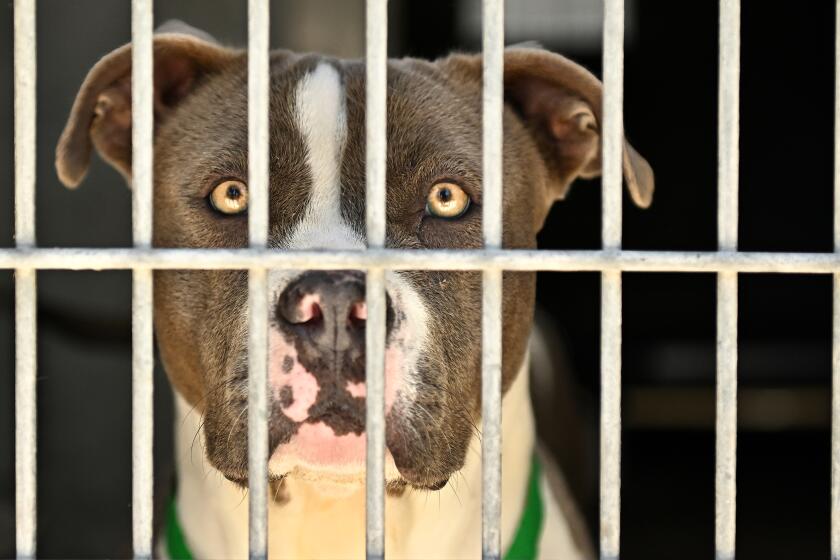Producers’ ‘Free Keiko’ Plan Criticized : Activism: Efforts to move the star of ‘Willy’ to an aquatic park disturbs environmentalists, who fear for the whale’s health.
- Share via
In the movie “Free Willy,” a young boy attempts to free an orca whale from a small Pacific Northwest aquatics park.
But efforts to move the movie’s star, the orca whale Keiko, from his Mexico City aquarium have put the film’s producers, Richard Donner and Lauren Shuler-Donner, at odds with some environmentalists.
Currently, the 5,000-pound orca lives in the Reina Avenpura aquatic park. It has been reported that the orca is suffering from a potentially contagious virus called viral pappilomatus.
Since Keiko suffers from a condition that is as yet incurable, experts at aquatics parks have been hesitant to see the whale’s release into the wild because his ailment is not yet found in the ocean. Similarly, there have been no takers among U.S.-based aquatics parks for Keiko, because he could still infect other orcas.
But Jerye Mooney of The Fund For Animals says that a recent pathology report on Keiko reveals that the orca is not suffering from the virus.
To Mooney, the report by veterinarian Lanny Cornell can make Keiko, once his rash-like skin condition clears up and he is taught survival skills, a candidate for release into the wild.
According to veterinarian experts, Keiko’s skin condition is directly related to the too-warm water in his too-small tank at the aquarium. They suggest that one probable cure for the orca is more ocean-like water temperatures, other than the above 80-degree pool he lives in.
But recently, producer Lauren Shuler-Donner, an animal-rights activist, proposed building a facility called the Marine Life Center near Sandwich, Mass., at a cost of $8 million to $12 million. Some funding would come from Warner Bros., which released “Free Willy.” Under this plan, Keiko would then be donated by the owners of the Mexico City aquatic park and moved there.
It was the announcement of this center, designed for rehabilitation of stranded marine animals, that environmentalists such as Mooney find disturbing. Mooney, who is in favor of releasing marine mammals in captivity back to their habitats, believes the stranding center is the same thing as a marine theme park.
“I think the Donners mean well,” Mooney says, but she believes moving Keiko to the porposed center damages the credibility of “Free Willy.”
Mooney recently acted as a liaison between Donner-Shuler-Donner Productions and The Fund For Animals in efforts to relocate Keiko. However, Mooney says she’s no longer working with the couple because she disagrees with their decision to move Keiko to the Massachusetts.
She worries that Donner and Shuler-Donner have made their decision on Keiko’s fate without seeing the updated pathology report.
Tim Desmond of Active Environments, whose animal behavior consulting firm assisted on “Free Willy,” disagrees with Mooney’s criticisms and fears over Keiko.
“I object to what the environmentalists want in the diminishing of the animal display industry,” says Desmond, who, after the filming of “Free Willy,” was approached by Richard Donner to be a consultant on the stranding center. “Instead, I would like to see the polarized sides of the animal rights issue set aside their philosophical viewpoints for the better of the animal.”
Shuler-Donner, states the proposed stranding center will not involve entertainment. “Keiko won’t be doing tricks or performing for people,” she says.
Instead, Shuler-Donner envisions a center that can be educational to university students and scientists, and will also work with existing stranding centers.
As to why the site was proposed in the New England area, Shuler-Donner says: “It has the largest number of sea mammal strandings anywhere in the United States. Being a stranding center, we feel that its location there will be very important.”
Environmentalists also raise questions about a veterinarian who may be associated with the Marine Life Center. Ontario-based veterinarian pathologist Dr. Joseph Geraci has been asked by the Donners to be involved with the center. Geraci (pronounced jer-AS-see), is known in the marine mammal community as a proponent of captivity, and environmentalists have even dubbed the Marine Life Center “Geraci Park.”
Geraci has been accused of experiments ranging from whale vivisections to a 1974 incident involving the pouring of oil into a seal tank to see how long the animals could survive.
Geraci did not return a reporter’s phone calls.
Dave Phillips of Earth Island Institute in San Francisco, which monitors the slaughter of whales, and whose 1-800 number appears in the credits of “Free Willy” as a place where viewers can receive information on helping sea mammals, says Donner-Shuler-Donner Productions have picked a “lightning rod” of controversy to head The Marine Life Center.
“Geraci has a few skeletons in his closet that have drawn the ire of the animal rights community,” Phillips says. “They say that having him direct a center that is about rehabilitation and release is like a fox in a hen house.”
Shuler-Donner said Geraci is merely one of several consultants brought into the program.
“I heard about (Geraci’s experiment),” Shuler-Donner said. “but that also was a long time ago. As far as the vivisections are concerned, I’m an animal rights activist. I belong to many rights groups. Whatever he did then, he won’t be doing here.”
More to Read
The biggest entertainment stories
Get our big stories about Hollywood, film, television, music, arts, culture and more right in your inbox as soon as they publish.
You may occasionally receive promotional content from the Los Angeles Times.










